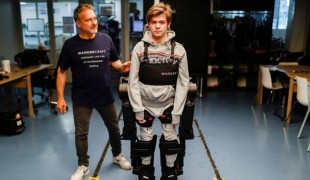- 9436
- 643
- 10
- 8
- 0
- Help Ukraine
About the solution
hughmorme's daughter was walking with a walker as a result of developmental delays. The cane was used to help her to transition away from the walker, and get familiar with the movement of the cane.
She used the cane for only a short time while she began to walk without it. It usually is a much more difficult to move from the walker to walking unassisted. The canes were purchased at a local pharmacy. They were the same size. By shortening one of the canes bottom sections, and modifying the cut section into two pieces, the "assistive" cane was created and the father was able to help his child through this transition.
The adult would walk behind the child. If successful, you will not need the longer section of the cane for long. Once the child is able to use the cane without adult assistance, the cane can be separated.
Adapted from : http://www.instructables.com/id/Training-Cane-for-Todler/
This solution shall not include mention to the use of drugs, chemicals or biologicals (including food); invasive devices; offensive, commercial or inherently dangerous content. This solution was not medically validated. Proceed with caution! If you have any doubts, please consult with a health professional.
DISCLAIMER: This story was written by someone who is not the author of the solution, therefore please be advised that, although it was written with the utmost respect for the innovation and the innovator, there can be some incorrect statements. If you find any errors please contact the patient Innovation team via info@patient-innovation.com
-
-
401
-
0
-
5589

Father creates exoskeleton to help son with genetic neurological condition walk
BODY BALANCE: Maintaining body balance
STANDING UP: Standing up from a seated position
WALKING WITH A WALKING AID: Walking with a walking aid
CAREGIVING
Cervical spinal cord injury/Tetraplegia
Assistive Technology access
Walking Aid (wheelchair/walker/crutches)
Restoring mobility
Managing pain
Promoting self-management
Preserving Organ Function
Managing Neurological Disorders
Recovering from Traumatic Injuries
Maintaining Balance and Mobility
Restoring Blood Circulation
To improve Treatment/Therapy
Preventing (Vaccination, Protection, Falls, Research/Mapping)
Raise awareness
Caregiving Support
General and Family Medicine
Intensive Care Medicine
Neurology
Physical Medicine and Rehabilitation
Sports Medicine
France
-
-
-
246
-
0
-
2702

Collaborator James Leckey makes equipment to improve the quality of life and social inclusion of children with special needs
MOVING IN A WHEELCHAIR: Moving using a wheelchair.
BODY BALANCE: Maintaining body balance
STANDING UP: Standing up from a seated position
Playing
Neuromuscular Disorders
Assistive Daily Life Device (to help ADL)
Walking Aid (wheelchair/walker/crutches)
Assistive Technology access
5 Senses support devices: (glasses, hearing aids, headphones...)
Restoring mobility
Promoting self-management
Managing Neurological Disorders
Promoting inclusivity and social integration
Maintaining Balance and Mobility
Raise awareness
General and Family Medicine
Neurology
Orthopedics
Pediatrics
Physical Medicine and Rehabilitation
United States
-
-
-
266
-
0
-
3948

Peter & Bernhard created StandSmart, a dynamic standing aid that supports the legs and trunk that allows hands free for productivity.
WALKING WITH A WALKING AID: Walking with a walking aid
BODY BALANCE: Maintaining body balance
STANDING UP: Standing up from a seated position
Cooking
Assistive Daily Life Device (to help ADL)
Walking Aid (wheelchair/walker/crutches)
Restoring mobility
Managing pain
Promoting self-management
Preserving Organ Function
Promoting inclusivity and social integration
Maintaining Balance and Mobility
Preventing (Vaccination, Protection, Falls, Research/Mapping)
Orthopedics
Physical Medicine and Rehabilitation
Mobility issues
Solutions for Disabled people
Germany
-
 en
en